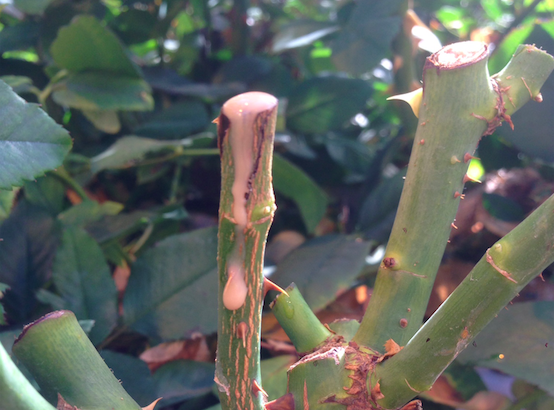The Netherlands Food and Consumer Product Safety Authority (NVWA) has confirmed that brown rot (Ralstonia solanacearum) was found at a Dutch cut-rose company. The company in question had already been closed since week 15. Clearing will begin soon.
By Hans Neefjes
The roses at the 2-ha nursery stopped growing in the beginning of this year. Branches no longer grew to the same length, new shoots hardly grew at all and buds were smaller and smaller.
The grower felt wary and had lab research done. That’s when Rsol was discovered in feedwater and plant samples, which meant the company was legally required to report it to the NVWA.
The authorities closed the company down in week 15, even if at that time, the contamination was officially only suspected. The NVWA shut down the company in order to prevent any further spread of the quarantine bacterium Rsol.
The results of extensive testing were published on Friday 20 April: the company is indeed contaminated with the Ralstonia solanacearum bacterium. In such cases the elimination scenario takes immediate effect, which means that all crops have to be cleared under the supervision of the NVWA.

Tracing investigations
In the meantime, NVWA started a tracing investigation in order to determine where exactly this contamination originated. Is this a case of a new infection or a reinfection? Rsol has been found before at the company in question. After complete clearance and thorough cleaning, they planted new roses. And after an intensive monitoring period, the NVWA declared the company clean in 2017.
NVWA research indicated that the bacterium in the newly contaminated material is directly related to the Ralstonia that was found at fifteen rose companies in 2015/2016. It’s Ralstonia solanacearum type 1, a tropical variant, which has a wide range of host plants, including tomato, pepper, aubergine, anthurium, gerbera, curcuma, geranium and rose.
Alert
The outbreaks of Rsol in 2015 and 2016 means that growers and propagators of cut rose have been on high alert. The number of samplings and tests during the cultivation and production of propagation materials for example, has dramatically increased. The number of preventive hygiene measures during the propagation and transportation of propagation materials has also gone up, because all infections that were found so far, were found in young plants. The source of the infection hasn’t been discovered yet.
LTO Glaskracht Nederland advises rose growers to stay alert and watch out for the Rsol bacterium, and to make clear agreements with plant suppliers (the outbreak has only been found in young plants so far). LTO Glaskracht Nederland is currently collaborating with Plantum and Naktuinbouw to develop a Plant Select system, with the aim of creating more closed chains for cut-rose plant materials.
Phytosanitary monitoring
In order to keep track of things, the NVWA is including R. solanacearum in their 2018 phytosanitary monitoring programme, for the cultivation, propagation and breeding of cut rose. As part of their phytosanitary monitoring programme, the NVWA inspects Dutch floricultural companies for the presence of harmful organisms.
Organisms are included in the programme when there’s a European reporting obligation after an outbreak, because the NVWA feels that there’s a risk that a certain harmful organism will be introduced or established, or because they want to underline the current pest status of a certain organism. So far, cut rose wasn’t included in the phytosanitary monitoring programme. The NVWA did check 10 anthurium companies for Ralstonia solanacearum last year.








